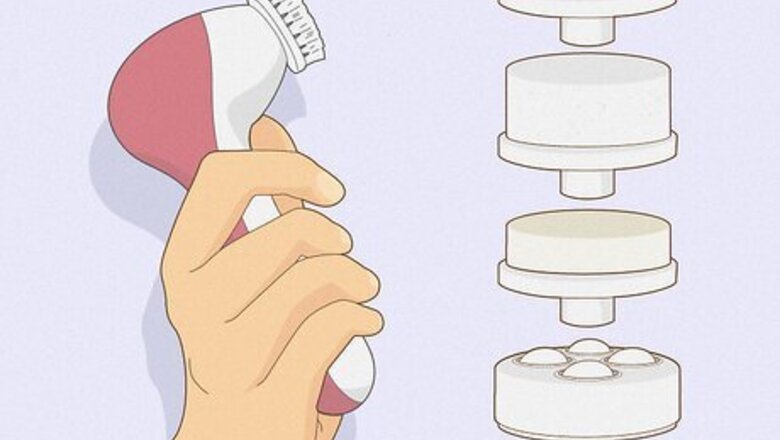
views
- Choose the right brush head for your complexion goals and skin type. Stiffer brushes are best for exfoliating, while softer brushes are better for sensitive skin.
- Remove any makeup from your skin. Then, wet the brush under warm water and apply a dollop of cleanser to the bristles.
- Work the brush over your skin in circular motions, spending about 20 seconds on each section of your face. Then, wash the cleanser off with water and pat your skin dry.
Cleaning Your Face with the Brush
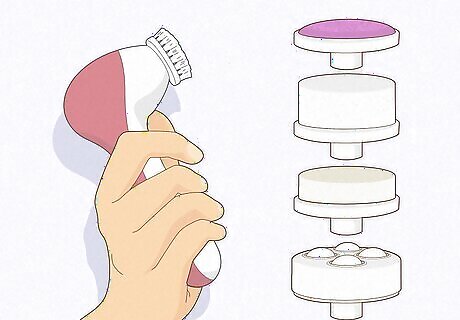
Select the right brush head for your complexion. Many facial brushes come with multiple types of heads that can be snapped on and off the base. Some are best for acne-prone complexions, while others work better for very dry, sensitive skin. Choose a brush head that's best suited to your skin type. Avoid facial brushes if you have rosacea, eczema, or psoriasis, or if your face is sunburned. If you're not sure what skin type you have, you can examine your face for certain characteristics to figure it out. A dermatologist can also help you determine your skin type. If you have acne prone skin, be careful to avoid overstimulation. Choose a brush head that is meant for your skin type.
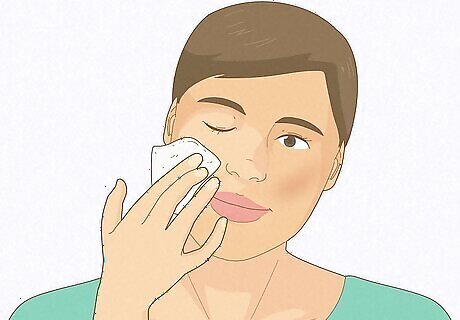
Remove any eye makeup, foundation, or lipstick with a cotton pad. Wet the pad with makeup remover. Press it gently against your eye for several seconds, then wipe it across your lids and lashes to remove any eyeshadow or mascara. Repeat with the second eye. Wet a second cotton pad and wipe off any foundation or lipstick, if needed.
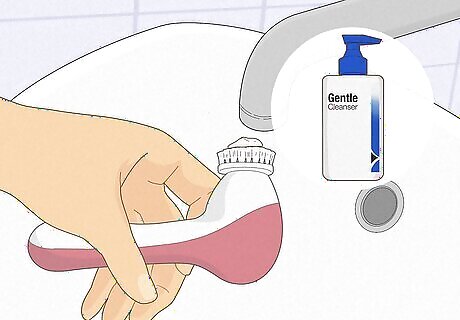
Wet the facial brush with warm water and apply cleanser to the bristles. Stick the brush head under your sink faucet to get it wet. Squeeze a nickel-sized dollop of facial cleanser onto the brush head. Facial brushes can be used with most types of face wash, although you will get the best clean if it's one that lathers. Avoid using a scrub or face wash that contains abrasive particles. Consider making your own face wash so that you can alter the ingredients to suit your needs. At this point, you can also choose to wet your face. It's optional, but some people find it allows the brush to glide more smoothly across the skin. It will also make it easier to remove any makeup from your skin.
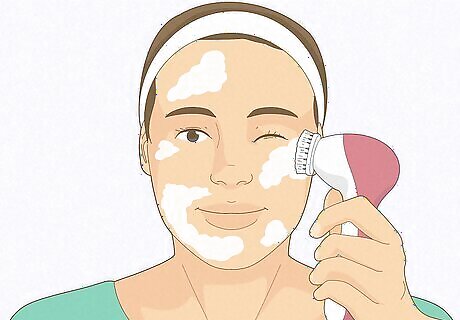
Start working the brush in small circular motions across your face. Do not use the facial brush for longer than 1 minute. Clean your chin, nose, and forehead for 20 seconds each. Clean each cheek for 10 seconds. Avoid using the brush on the delicate skin around your eyes no matter what type of bristles it has on it. Work the brush into hard to reach areas, such as your eyebrows and the sides of your nose. Keep the brush moving. Don't hold it over one spot for too long.
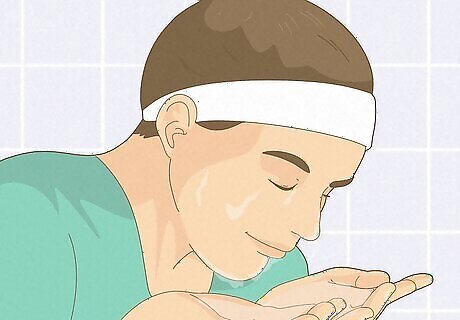
Rinse your face with lukewarm water, then pat it dry. Once you've used the facial brush to clean your entire face, turn the brush off, put it down and rinse the soap off your face with warm water from the sink. Once you've removed all of the soap residue, use a clean, dry towel to pat any remaining moisture off your face. You can also splash a bit of cold water onto your face after rinsing. This will help to close up your pores a bit after they've been exfoliated by the facial brush.
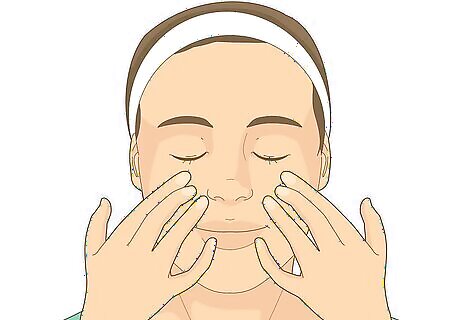
Apply any topical medications, then finish off your cleansing routine. After cleaning your face thoroughly with the facial brush, you can complete any other steps in your traditional cleansing routine, such as toning and moisturizing. If you use topical medications, apply those first. Then, follow up with moisturizer and other products.
Cleaning the Brush
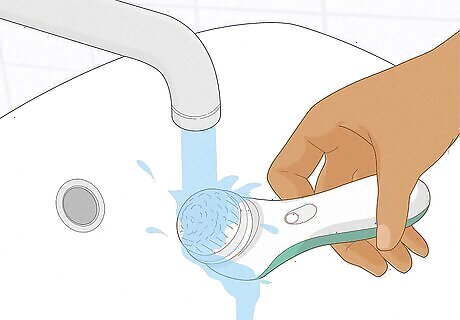
Wash your facial brush under running water to remove makeup residue. Rinse the bristles under clean running water after cleaning your face. Rub the bristles with your fingers under the water to make sure that you've gotten rid of any soap or other residue. You can even use mild liquid soap or even baby shampoo to get rid of any tough-to-remove makeup. Once you've cleaned out the brush, pat it dry with a towel and allow it to air-dry. It's very important to clean your brush head after every single use. Otherwise, dirt and makeup that may have gotten on the bristles will cause breakouts the next time you use the brush.
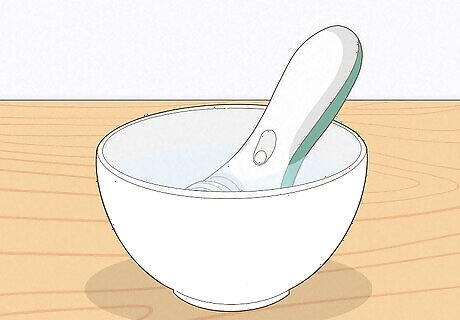
Rinse your brush in gentle alcohol-based disinfectant each week. Fill a bowl with enough disinfectant that it covers the brush head, drop it in, and allow it to soak for a minute. Allow the brush to air-dry on a towel without rinsing it off. This helps to kill any bacteria that may be on the bristles after using the brush daily. Before you use the brush again, make sure you've thoroughly rinsed the bristles. The disinfectant could be irritating to your skin.
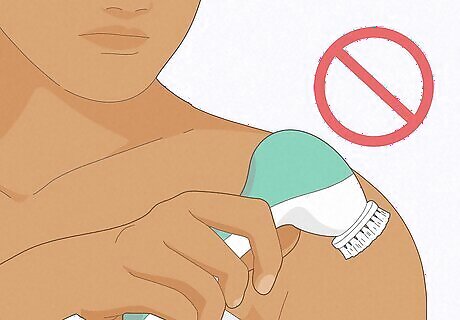
Avoid using the same brush head for different areas of the body. If you have other areas of the body that are prone to breakouts, use a new brush head rather than the same one you use on your face. Using the same brush head for your entire body will cause an imbalance in bacteria and result in worse breakouts.
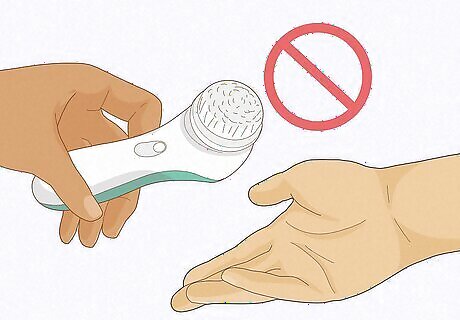
Do not share your brush head with other people. Sharing your brush with others can spread bacteria. If you want to share a brush with your roommate or partner, share the motorized base and simply switch out the brush head each time you use it. Sharing a brush head between two people can result in breakouts and inflammation.
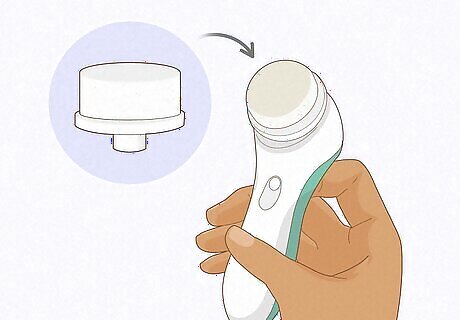
Change your brush head every 3 months if you use it daily. Make sure to check the instructions on your particular brush, which may advise that you change the brush head more or less frequently. However, 3 months is a good rule of thumb if you use your brush everyday. If you only use your facial brush once or twice a week, you can wait longer before replacing your brush head. Check the directions included with your particular brush to see what the company advises.
Figuring Out a Routine
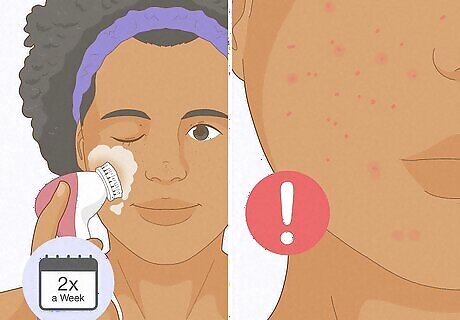
Start by using the brush once or twice a week to test its effects. A facial brush can affect your face in different ways when you first start using it. For instance, your face may break out during the first week or two you use the facial brush. This is normal—the dead skins cells that are being scraped off can initially clog up your pores. Before you try your facial brush for the first time, consider using a face wash that contains salicylic or glycolic acid as a preventative measure for any acne flare-ups. Just make sure not to use this type of face wash with the brush as you may irritate your skin. Alternate days using an exfoliating wash and the facial brush. If your skin reacts with a breakout, stop using the facial brush for a few days. Once the pimples have started to fade, gradually reintroduce the brush into your routine.
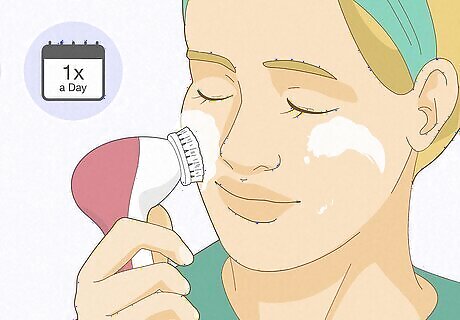
Clean your face with the brush once day if you have a normal skin type. Although some facial brush companies recommend using their product twice a day, most dermatologists say once a day is the maximum number of times you should use a facial brush. Any more and you run the risk of being too harsh on your skin and causing irritation. It's best to use the facial brush to clean your skin in the evening, after the day's dirt and oils have built up.
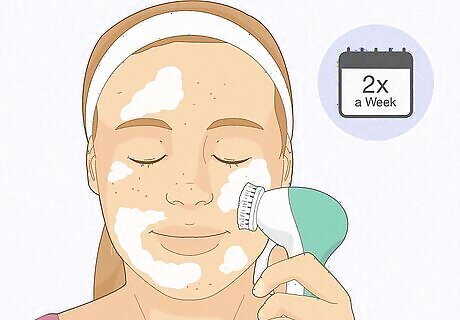
Use the brush once or twice a week if you have a sensitive complexion. Although a facial brush can be great for exfoliating and opening up pores, it can quickly become too harsh for more sensitive skin types. If your face is on the sensitive side, consider using your facial brush just once or twice a week to prevent irritation. You can have to test out different routines in the beginning to figure out what works best for your specific skin type.




















Comments
0 comment